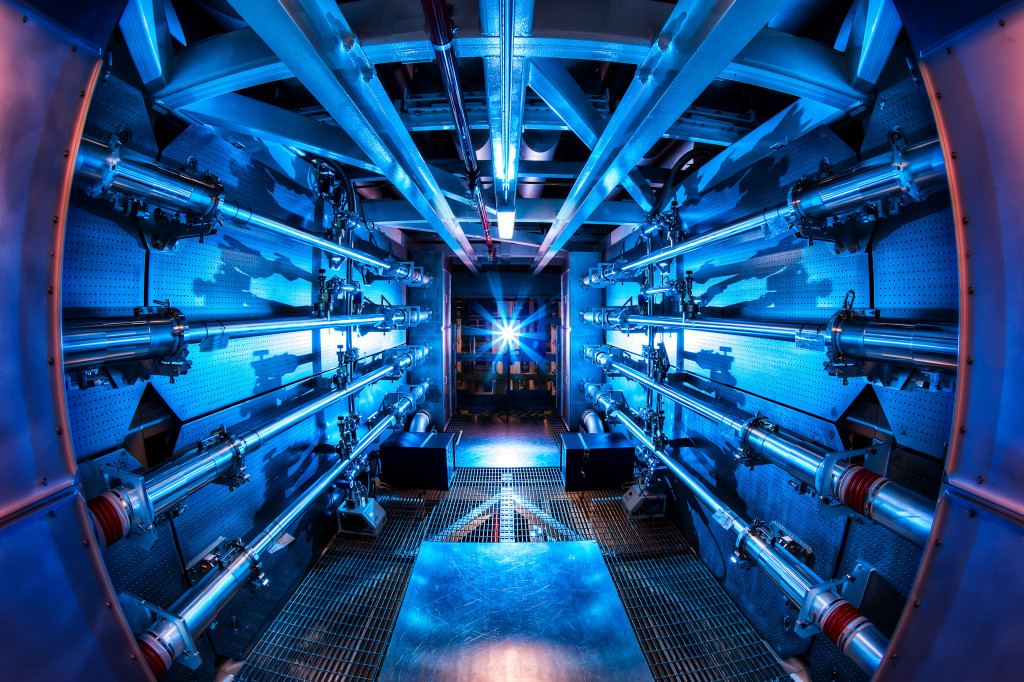[Update: Apparently the BBC didn’t quite get the story correct. In order for the NIF to put out more than the total energy put in, there would have to be true ignition of a hydrogen fusion reaction. The experiment in question did not achieve that goal. Instead, in this experiment the energy released by the tiny ball of hydrogen was greater than the energy that it absorbed, indicating that at least some of the atoms in the hydrogen were approaching fusion. However, the total energy output in no way approached the total energy input. By my reading it was only something like .77% the energy put in. Still it is a huge deal that the hydrogen put out more energy than it absorbed. It was moving toward fusion. Here is a great article from Science which clarifies the situation. Thanks to Alex Evans for pointing me to it.]
I think this story has kind of been lost behind all the “sound and fury signifying nothing” coming from the District in the last week. In case you missed it, humanity took a huge technological leap forward recently.
For the first time in our history, an attempt at a controlled fusion reaction generated more energy than was needed to create the fusion reaction itself. Now before you line up at Best Buy for your Mister Fussion with attached flux capacitor, the amount generated wasn’t enough to make the reaction self-sustaining. There are too many inefficiencies in the system. Basically the feedback loop is still too leaky, but it is still a momentous day for human beings.
Why? Because a true fusion reactor offers an effectively unlimited supply of clean energy for our planet. So much of the environmental damage we do comes from our use of fossil fuels for energy. A fusion based energy system would greatly reduce the need for those sources of energy. It’s a worthy goal, and our U.S. tax dollars spent by the National Ignition Facility (NIF) at the Lawrence Livermore National Laboratory brought us one step closer this week.
Some of you may be saying, what about the radioactive waste? The great thing about fusion is that it offers something like our current nuclear power without any of the radioactivity. When you fuse hydrogen to make helium it doesn’t create any radioactive waste.
Now a hydrogen fusion bomb does create radioactivity because the best way to compact enough hydrogen so that you get a bomb is to use a traditional fission bomb to generate the tremendous forces necessary to start a larger fusion reaction. So the fusion part of the H-bomb doesn’t create radiation but the fission reaction we use to get the H-bomb going does create lots of deadly radioactivity.
If you happened to be thinking to yourself that the fusion reactor looks just like something out of a Star Trek film, you would be correct. The NIF was used as the back drop for the warp core in the recent film Into Darkness. So this is truly a case of science fiction reflecting reality.
The best part, the NIF’s fusion reaction was all done with the worlds most powerful laser. For a science nerd like me, I’m not sure it gets much cooler than that. You can read more over at the BBC.


I love it..stop the stupid and insane wars and look what funding would do to advance this research….thanks for posting!!
It all makes me wish Elon Musk would take on fusion power. It would be done snappy quick and with a business purpose in mind.
AWESOME idea! Have you asked him? 😉
Maybe, we should. We could start a change.org petition or something. Ha!
If I read correctly it was a 75% increase in power output over previous attempts which is nothing to sneeze at. If they can continue at that rate we should see better than 1 to 1 in a few short years.